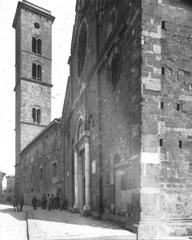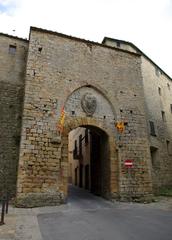Museo Della Tortura Volterra: Visiting Hours, Tickets, and Historical Sites Guide
Date: 14/06/2025
Introduction
Nestled within the ancient walls of Volterra, the Museo Della Tortura stands as a unique and sobering testament to the darker chapters of European history. This museum, also known as the Medieval Criminal Museum, offers a comprehensive exploration of judicial torture and execution from the Middle Ages to the Industrial Age. Through authentic artifacts, detailed reconstructions, and rich contextual information, visitors are invited to reflect on the evolution of justice and the ongoing importance of human rights. Whether you are a history aficionado or an ethically-minded traveler, this guide provides all essential details for planning your visit, including Museo Della Tortura visiting hours, ticketing, accessibility, and nearby cultural attractions (Terre di Pisa, Trek Zone, Museionline).
Historical Origins and Significance
Founded in the late 20th century, the Museo Della Tortura in Volterra forms part of a network of European institutions dedicated to preserving the history of judicial torture and capital punishment. Volterra—renowned for its Etruscan, Roman, and medieval heritage—provides a fitting backdrop for a museum that documents the evolution of punitive practices. The collection explores the legal, religious, and social contexts in which torture was sanctioned, with a particular focus on the Inquisition and public punishment (Cosavedere a Volterra).
By displaying both original and reconstructed artifacts, the museum not only exposes the grim realities of the past but also encourages critical reflection on the nature of justice and the development of human rights over time.
Exhibitions and Thematic Focus
Instruments of Torture and Execution
The museum boasts an extensive array of torture devices and execution instruments from across Europe. Notable exhibits include:
- Iron Maiden: A legendary sarcophagus lined with spikes, blending myth and historical fact.
- Guillotine: Representative of the industrialization of execution during the French Revolution.
- Pointed Throne, Rack, and Breaking Wheel: Devices that exemplify medieval and early modern methods of punishment.
- Public Humiliation Tools: Stocks, pillories, and branks (scold’s bridles).
- Interrogation Chair and Knee Splitter: Instruments designed to extract confessions.
- Inquisition Implements: Artifacts and documentation connected to religious persecution.
Artifacts are accompanied by multilingual panels explaining their historical uses and contexts (Museionline).
Contextual Interpretation
Each device is situated within the broader frameworks of European law, religion, and society. The museum highlights how torture was institutionalized, especially during the Inquisition, and how public executions and shaming functioned as tools for enforcing order. Supplementary materials—such as period engravings and rare documents—provide further insight into these practices (Terre di Pisa).
Authenticity and Ethical Framing
While many exhibits are genuine, some are reconstructions due to the perishability of original materials. The museum has faced critique for occasionally blurring the line between historical fact and legend, but it maintains an educational mission, prompting ethical reflection and collaborating with organizations such as Amnesty International to connect historical lessons to contemporary human rights issues (Zingarate Blog).
Visitor Information
Location and Accessibility
- Address: Piazza XX Settembre 3, Volterra, Italy
- Centrally located near other landmarks such as the Viti Palace and the Art Gallery and Civic Museum.
- The museum is pet-friendly and allows dogs inside (Zingarate Blog).
- Wheelchair access may be limited due to the historic nature of the building; contact the museum for details.
Visiting Hours
- April–October: Daily, 10:00 AM – 7:00 PM
- November–March: Saturdays and Sundays, 10:00 AM – 6:00 PM
- Confirm hours on the official Museo della Tortura website before visiting.
Tickets
- Full Price: €8.00
- Reduced Price (students, seniors): €6.00
- Group Tickets: €4.00
- Children under 10: Free
- Tickets are available at the entrance or online (Museionline).
Guided Tours and Special Events
- Guided tours may be offered—check for availability and timings.
- The museum periodically hosts special exhibitions and events in collaboration with human rights organizations.
Visitor Experience and Tips
- Allow 45–90 minutes for your visit.
- The museum’s atmosphere is somber due to the nature of the exhibits.
- Not recommended for young children or sensitive visitors due to graphic content.
- Multilingual descriptions ensure accessibility for international guests.
- Nearby parking is available outside the city walls; a short walk through Volterra’s historic streets leads to the museum.
Nearby Attractions in Volterra
Enhance your visit by exploring other Volterra historical sites:
- Museo Etrusco Guarnacci: A treasure trove of Etruscan artifacts.
- Palazzo dei Priori: Tuscany’s oldest town hall.
- Volterra Cathedral: A stunning example of Romanesque architecture.
- Fortezza Medicea: Imposing fortress with panoramic views.
- Viti Palace: Renowned for its Renaissance art and architecture.
Frequently Asked Questions (FAQs)
Q: What are the Museo Della Tortura visiting hours?
A: April–October, daily 10:00 AM–7:00 PM; November–March, weekends 10:00 AM–6:00 PM.
Q: How much are Museo Della Tortura tickets?
A: €8.00 for adults, €6.00 reduced, €4.00 for groups, free for children under 10.
Q: Is the museum suitable for children?
A: The content is graphic and not recommended for young children or sensitive visitors.
Q: Are pets allowed?
A: Yes, dogs are permitted inside the museum.
Q: Is the museum accessible for visitors with disabilities?
A: Accessibility is limited; contact the museum before visiting for specific accommodations.
Q: Can I take photographs?
A: Non-flash photography is generally allowed; check individual exhibit signs for restrictions.
Visuals and Digital Resources
- High-quality images and virtual tours are available on the museum’s website.
- Alt text suggestions: “Museo della Tortura Volterra entrance,” “Iron Maiden on display at Museo della Tortura,” “Rack torture device Volterra museum.”
- Downloadable maps and visitor guides are recommended for planning.
Travel Tips
- Combine your museum visit with a walking tour of Volterra’s medieval streets.
- Visit during weekday mornings or late afternoons to avoid crowds.
- Enjoy local Tuscan cuisine at nearby trattorias after your museum experience.
Conclusion
The Museo Della Tortura in Volterra provides an essential, if challenging, perspective on the history of justice and punishment in Europe. Through its curated exhibits and educational approach, the museum encourages visitors to confront the realities of the past while reflecting on the ongoing need for human rights advocacy. Complement your visit by exploring Volterra’s other rich historical and cultural offerings.
For the most current information on Museo Della Tortura visiting hours, tickets, and exhibitions, consult the official website.

